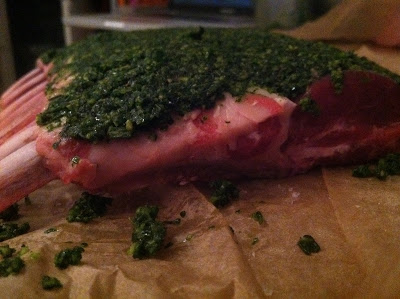As I’ve alluded to in the past, I tend not to cook red meat very often. I enjoy ordering it at restaurants where I trust I’ll be served a perfect medium rare, but in my own kitchen, a few expensive failures have left me inclined to defer to more experienced hands when I crave it.
But lately I’ve been in the mood to conquer, so I decided that I would attempt to get back on the wagon for Valentine’s Day dinner, a tradition that Jake and I keep in lieu of dropping cash on an overpriced “romantic tasting menu” at a crowded restaurant. No heart shaped chocolate cake for us, thanks.
This year we decided on rack of lamb, one of our favorite proteins but something I’d never attempted. So I temporarily shelved all memories of overcooked disappointment and committed to this dinner. For cooking method, I consulted one of my favorites – Williams-Sonoma’s Cooking at Home, and after reading up a bit, felt reasonably confident that this was something I could do. Rack of lamb was happening.
Spoiler: we were not unique in our ambition. In an uncharacteristic rookie mistake, we showed up to the grocery store fully unprepared to contend with the mob scene of hungry couples that all had the exact same idea. Word to the wise, Whole Foods on Valentine’s Day is an ugly scene. So we opted for plan B, which in our house means pizza, beer and Smash on DVR. Greasy carbs and musical theatre are pretty much my dream back up combination, and I’m lucky enough to have a boyfriend who indulges these guilty tendencies. (He also loves Debra Messing. It’s true.)
We ended up making our belated Valentine's meal the following weekend. Here’s the recipe, along with a few observations on the techniques that helped successfully bring this dish across and mitigated the intimidation factor surrounding red meat. Read: patience.
When it’s done, carefully remove your skillet from the oven (that shit is going to be hot) and move the lamb to a plate to rest. Let it sit for 5 minutes before carving between the ribs, and serve with the herb butter and a drizzle of aged balsamic vinegar if you're so inclined. We ate the lamb with a creamy celery root puree that I found here, and some cherry tomatoes I halved and simmered in a pan with olive oil until their juices were thick, about 10 minutes.
We ended up making our belated Valentine's meal the following weekend. Here’s the recipe, along with a few observations on the techniques that helped successfully bring this dish across and mitigated the intimidation factor surrounding red meat. Read: patience.
Recipe:
1 frenched rack of lamb, 8 ribs
4 garlic cloves
¼ cup each mint, rosemary and parsley
4 tablespoons olive oil, plus more for searing
salt and freshly ground black pepper
Remove excess fat from the top of the rack, then generously salt both sides and set it aside. In a food processor, combine the garlic, herbs and pepper and pulse until everything is finely chopped, then slowly add in the olive oil until a nice, thick paste has formed.
Take two thirds of the paste and spread it on the top of your rack, so it looks like this, and let it sit for an hour so the flavors can begin to permeate the lamb. Meanwhile, preheat your oven to 450.
Heat an oven safe skillet (I used a cast iron) to medium/high and add a few tablespoons of olive oil, enough to coat the bottom. When the oil begins to smoke, add the lamb, herb paste down, and sear for two minutes, then flip it and sear the other side for an additional two.
Place the skillet in the oven with your lamb herb paste up and roast 10 minutes for medium rare. While the lamb is roasting, melt the remaining herb paste into 2 tablespoons of butter in a small sauce pan over low heat.

A few revelations occurred to me as I beamed at my finished product. These may be shamefully obvious to all of you, but as someone who is not especially patient in cooking or in life, getting my desired result really drove home the impact of these techniques (which are really just logical actions I sometimes don't take because I don't like waiting).
For one, if you're searing something, wait until your pan is hot. Really wait. If your meat isn't sizzling as soon as you place it in the pan, you're never going to get the sear you want. And the big one. Let your meat rest and trust in carry over heat to increase the temperature by five to ten degrees. Cutting it prematurely will disrupt the meat from arriving at its true temperature, and cause it to dry out, which is a bummer.
I know it's tempting to check and see if you've undercooked it, but that 5 minutes can make all the difference. I had to consciously restrain myself, but the end product made for a pretty fantastic belated Valentine's Day dinner. For the record, we've committed to shopping a little earlier next year.







No comments:
Post a Comment